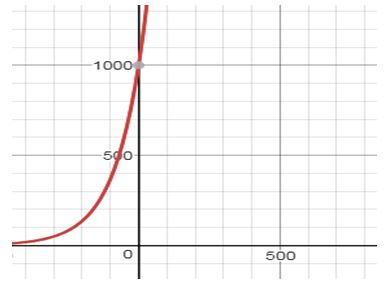
Concept explainers
Growth of Bacteria The number of bacteria present in a culture at time (in hours) obeys the model .
(a) Determine the number of bacteria at hours.
(b) What is the growth rate of the bacteria?
(c) Graph the function using a graphing utility.
(d) What is the population after 4 hours?
(e) When will the number of bacteria reach 1700?
(f) When will the number of bacteria double?
To find:
a. Determine the number of bacteria at hours.
Answer to Problem 2AYU
Solution:
a. 1000
Explanation of Solution
Given:
Calculation:
Let us consider 1000 bacteria initially and the number of bacteria after hours will be
a. Let us consider the initial state. Then
To find:
b. What is the growth rate of the bacteria?
Answer to Problem 2AYU
Solution:
b.
Explanation of Solution
Given:
Calculation:
Let us consider 1000 bacteria initially and the number of bacteria after hours will be
b. Let us compare the above model with where defines the growth rate of the model. Then .
To find:
c. Graph the function using a graphing utility.
Answer to Problem 2AYU
Solution:
c.

Explanation of Solution
Given:
Calculation:
Let us consider 1000 bacteria initially and the number of bacteria after hours will be
c. Graph:

To find:
d. What is the population after 4 hours?
Answer to Problem 2AYU
Solution:
d. 1041
Explanation of Solution
Given:
Calculation:
Let us consider 1000 bacteria initially and the number of bacteria after hours will be
d. Let us consider hours. Then
To find:
e. When will the number of bacteria reach 1700?
Answer to Problem 2AYU
Solution:
e.
Explanation of Solution
Given:
Calculation:
Let us consider 1000 bacteria initially and the number of bacteria after hours will be
e. Let us consider . Then
Taking log on both sides we get,
hours
To find:
f. When will the number of bacteria double?
Answer to Problem 2AYU
Solution:
f.
Explanation of Solution
Given:
Calculation:
Let us consider 1000 bacteria initially and the number of bacteria after hours will be
f. Let us consider .
Taking log on both sides we get,
hours
Chapter 5 Solutions
Precalculus
Additional Math Textbook Solutions
Elementary Statistics (13th Edition)
Calculus for Business, Economics, Life Sciences, and Social Sciences (14th Edition)
Calculus: Early Transcendentals (2nd Edition)
College Algebra (7th Edition)
Introductory Statistics
A Problem Solving Approach To Mathematics For Elementary School Teachers (13th Edition)
- a -> f(x) = f(x) = [x] show that whether f is continuous function or not(by using theorem) Muslim_mathsarrow_forwardUse Green's Theorem to evaluate F. dr, where F = (√+4y, 2x + √√) and C consists of the arc of the curve y = 4x - x² from (0,0) to (4,0) and the line segment from (4,0) to (0,0).arrow_forwardEvaluate F. dr where F(x, y, z) = (2yz cos(xyz), 2xzcos(xyz), 2xy cos(xyz)) and C is the line π 1 1 segment starting at the point (8, ' and ending at the point (3, 2 3'6arrow_forward
- I need help in ensuring that I explain it propleryy in the simplifest way as possiblearrow_forwardI need help making sure that I explain this part accutartly.arrow_forwardPlease help me with this question as I want to know how can I perform the partial fraction decompostion on this alebgric equation to find the time-domain of y(t)arrow_forward
- Please help me with this question as I want to know how can I perform the partial fraction on this alebgric equation to find the time-domain of y(t)arrow_forwardEvaluate F³ - dr where ♬ = (4z, -4y, x), and C' is given by (t) = (sin(t), t, cos(t)), 0≤t≤ñ .arrow_forwardMid-Term Review Find the formula for (f + g)(x). f(x) = x² - 10x + 25 and g(x) = x² - 10x + 24 (f + g) (x) = [ 2 ]x² X + DELL Skip Sarrow_forward
 Calculus: Early TranscendentalsCalculusISBN:9781285741550Author:James StewartPublisher:Cengage Learning
Calculus: Early TranscendentalsCalculusISBN:9781285741550Author:James StewartPublisher:Cengage Learning Thomas' Calculus (14th Edition)CalculusISBN:9780134438986Author:Joel R. Hass, Christopher E. Heil, Maurice D. WeirPublisher:PEARSON
Thomas' Calculus (14th Edition)CalculusISBN:9780134438986Author:Joel R. Hass, Christopher E. Heil, Maurice D. WeirPublisher:PEARSON Calculus: Early Transcendentals (3rd Edition)CalculusISBN:9780134763644Author:William L. Briggs, Lyle Cochran, Bernard Gillett, Eric SchulzPublisher:PEARSON
Calculus: Early Transcendentals (3rd Edition)CalculusISBN:9780134763644Author:William L. Briggs, Lyle Cochran, Bernard Gillett, Eric SchulzPublisher:PEARSON Calculus: Early TranscendentalsCalculusISBN:9781319050740Author:Jon Rogawski, Colin Adams, Robert FranzosaPublisher:W. H. Freeman
Calculus: Early TranscendentalsCalculusISBN:9781319050740Author:Jon Rogawski, Colin Adams, Robert FranzosaPublisher:W. H. Freeman
 Calculus: Early Transcendental FunctionsCalculusISBN:9781337552516Author:Ron Larson, Bruce H. EdwardsPublisher:Cengage Learning
Calculus: Early Transcendental FunctionsCalculusISBN:9781337552516Author:Ron Larson, Bruce H. EdwardsPublisher:Cengage Learning





